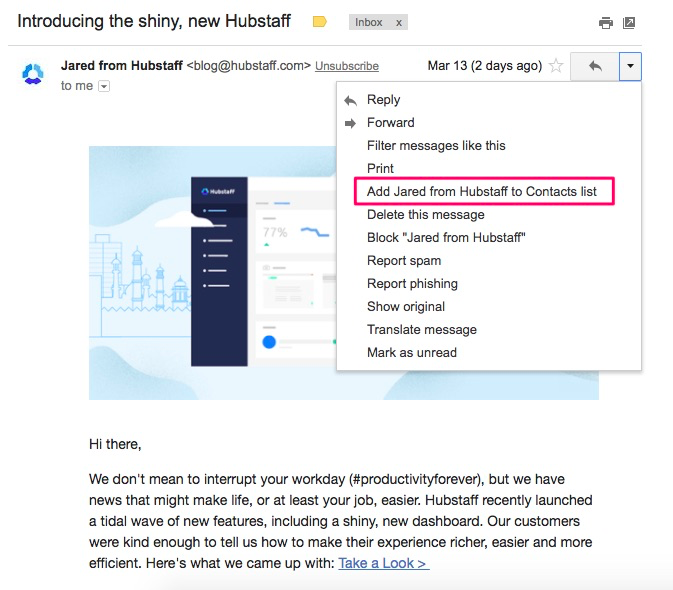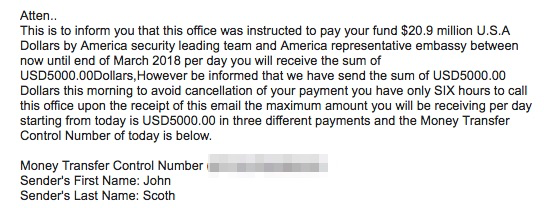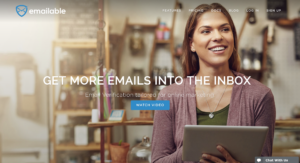How to avoid sending emails to the trash
Statistics like this are worrisome when you're organizing an email marketing campaign. But don't worry - we've got your back. We don't want your email to be just another statistic, we've written the following guide to help you keep your email out of the junk folder and recipient's inbox. So, without further ado, here are 12 things you must do to keep your email from becoming spam.
1. Ask subscribers to whitelist your email address

Whitelist email addresses in Gmail .
Google , Microsoft and Yahoo! Everyone works hard to make sure their email program spam filters don't catch emails from people in your contacts. These companies (correctly) assume that if an email comes from someone in your contacts, it's not spam.
To ensure your emails receive this privileged treatment, please allow your subscribers to whitelist your emails by adding your "From" address to their Contacts or Safe Senders lists. list. We recommend including instructions and screenshots on how to do this, as you should not assume that all subscribers have the technical ability to whitelist emails.
To ensure that all of your email gets this treatment, please include whitelisting instructions in the first welcome email you send when someone joins your email list .
2. Always get permission to send emails
Nothing will mark your email as spam faster than sending it without permission. Think about what you do when you get an email from an unknown sender. Assuming this email even passes your email service's spam filter, you don't even need to open it to mark it as spam.
Sending marketing emails to people without permission is not a recipe for business success in the long run. If you want to convince subscribers to buy from you, you want them to be engaged and interested. Random email recipients aren't either; they're indifferent at best and more likely to be annoyed at getting emails from people they don't know. Always get permission before sending emails; this is an ethical and economic best practice.
3. Comply with the laws governing email marketing
When it comes to ethics, you need to understand the laws that govern digital marketing communications. In particular, you should be familiar with the CAN-SPAM Act , which outlines the practices you must use when sending commercial emails.
You don't need to read every line of the law, but you should know that there are severe penalties for spamming. How do you know if an email is (legitimately) spam? The CAN-SPAM Act defines spam as you:
- Sent without the recipient's permission.
- Do not include a mailing address when sending.
- Send a deceptive subject line.
- Sent without including the recipient's means of opting out.
You don't have to worry too much about the above, as all modern email marketing programs make sure you honor your mailing address and opt out by default. But you should be careful with your subject line, which we'll explore in more detail later in this article.
4. Use a reputable email marketing plan
One sign that spam filters look for when trying to catch mail is to look at the IP address associated with the sending email address and see if there are any spam complaints associated with it. If so, legitimate email addresses may be flagged for association.
To make sure this doesn't happen to your email, always use a reputable email provider. All of the top providers take steps to prevent spammers from using their platforms, which helps ensure that malicious behavior by spammers doesn't compromise the deliverability of your emails.
Also, as we've already mentioned, the best email marketing software providers will also have built-in features to help you avoid other common spam triggers, such as not including an actual address or sending emails with suspicious looking address.
5. Proofread your email
If your email sounds sloppy (or computer-written), it could be a red flag for a spam filter. If your email is occasionally misspelled, it won't cause you any serious trouble. But if your emails are littered with misspellings, grammar mistakes, and sentences that sound...closed, there's a chance that spam filters will block them.
For example, take a look at this real phishing email:

While you wouldn't write an email with such extreme questions, it does provide valuable lessons on how spelling, formatting, and grammatical errors are all hallmarks of spam. If you're not comfortable with your grammar skills, get someone you trust to proofread your email for you, or at least use a program like Grammarly to spot basic grammar mistakes.
6. Don’t write spam subject lines
While specific lists of "spam trigger words" needed to be avoided in marketing emails in the past, spam filters are now much more sophisticated. So instead of focusing on specific words to avoid, think more holistically and make sure you don't write spam-sounding subject lines.
For an example of a spam subject line, check out the screenshot below, taken from a real Gmail spam folder.

As you can see, some of these emails are from legitimate brands like Lyft, Dollar Shave Club, and FareDepot. However, due to the wording chosen by the email marketers of these companies, these emails end up being spam. Notice how many of these emails mention money, use too many exclamation points, or generally promise discounts.
Does this mean you should never send emails with discounts or offers in the subject? Of course not, but it does suggest that you should be careful with these types of subject lines. For more information, you can view our email subject line best practices guide.
7. Clear abandoned email addresses from your list
One metric that spam filters use to catch false emails is to see how many of the emails you send are active. If the percentage is too low, it may indicate that you are sending spam content.
To make sure this doesn't happen, you should periodically delete addresses associated with email accounts that appear to be inactive. If someone hasn't opened your email in a long time, it's probably safe to remove them from your list. You can think of this as pruning a tree. You now cut out small pieces to ensure the overall continued health of the organism.
Of course, this advice only applies if your few subscribers don't engage with your content. If you have a low email open rate overall, then you may need to reconsider your overall email marketing strategy, as this may indicate a deeper problem than just a few inactive email addresses.
8. Use a spam checker

Wouldn't it be nice to have a program that could tell you if your emails might have been caught by spam filters, or if they were still valid? It turns out that such an application exists.
One of our favorites is Emailable. Just send your email to the email address they provide and receive an automatic report on the likelihood of your email going into your recipient's spam folder.
9. Have a clear sender address
When someone views your email, your sender address will appear in the "From" field. If your sender address is full of random characters or sounds suspicious, your email may be marked as spam.
Therefore, we recommend avoiding sender addresses that contain a lot of numbers or garbled characters. Stick with one person's name or your business name. Not only does this help keep you out of spam, but it's also more personal than a string of random characters that people start to associate with automated emails rather than compelling personalized offers.
10. Send regular emails to your subscribers
If you only send an email every two months, you risk making subscribers forget who you are or why they subscribed. If this happens, they may unsubscribe or even mark your email as spam when they finally hear back from you.
To prevent this from happening, keep in regular contact with your subscribers. Of course, you should always provide value when you email; don't just email your subscribers at a certain frequency, as it's "best practice" to do so.
Instead, look for as many opportunities as possible to provide value to your subscribers. If it's just once a week, that's fine, as long as you keep sending them weekly emails (and use smart timing to make sure they get emails when they're most likely to open).
11. Unsubscribe easily

Making it easy for your subscribers to leave your email list may seem like counterintuitive advice, but it's the key to complying with the CAN-SPAM Act and ensuring subscribers trust you. While compliance with the law is your top priority, including a way to unsubscribe also shows subscribers that you have confidence in the value of your content. After all, if you don't think your emails are great, why send them in the first place?
How easy it is to cancel a subscription is up to you. Some brands take the confidence approach to the extreme, placing an unsubscribe button in the header and footer of emails. While you can do this, if you put it in the header, people may also unsubscribe or click the button by mistake without reading the email.
So we think a standard unobtrusive unsubscribe button in the footer of an email is the way most ecommerce entrepreneurs go. See the screenshot above from Stack Overflow emails for an example of this, and keep in mind that your email marketing software already has this functionality built into its templates.
12. Be honest
We've already mentioned how the CAN-SPAM Act prohibits sending spoofed emails, but this point deserves further exploration. Most importantly, you should always be honest with your email marketing. Don't write a subject line that tricks people into opening your email.
Specifically, don't write things that make the email look like it's from someone's employer, don't make the subject line threatening or alert, or the email address looks like it's from someone who isn't. Resorting to cheap tricks like this is not the way to run a business. Instead, focus on how to create value for your subscribers. When you give them a good offer, the money will take care of itself.
We hope you now understand what causes emails to end up as spam, and what you can do to stop them from going to spam. As long as you follow the best practices we've outlined above, you can rest assured that the emails you send will end up in your subscribers' inboxes instead of being buried in spam folders.
Next, check out our resources page for helpful guides and tutorials to help you get the most out of your email marketing.
Like my work? Don't forget to support and clap, let me know that you are with me on the road of creation. Keep this enthusiasm together!

- Author
- More